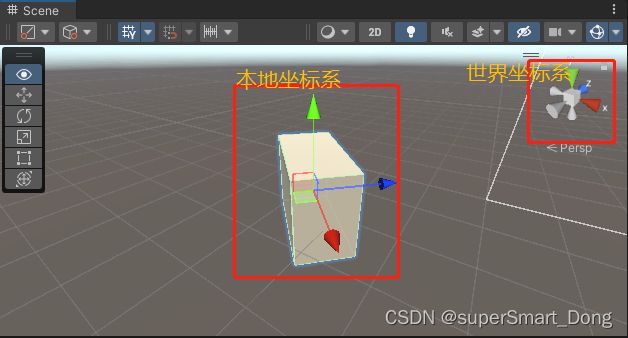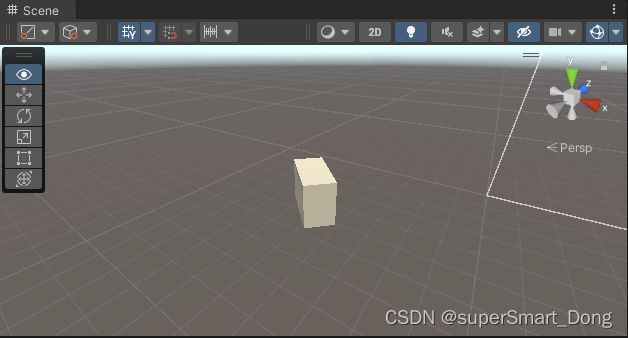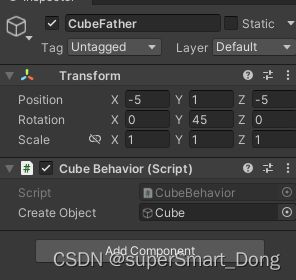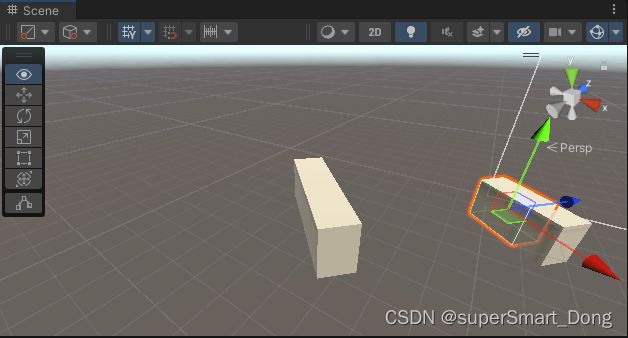Unity3D : 本地坐标系,世界坐标系,和TransformPoint,TransformVector,TransformDirection的区别
目录
一、世界坐标系与本地坐标系
二、srcGameObject.transform.TransformPoint(Vector3 vec)
三、srcGameObject.transform.TransformVector(Vector3 vec)
四、srcGameObject.transform.TransformDirection(Vector3 vec)
五:示例
一、世界坐标系与本地坐标系
世界坐标很好理解,就是模型的 transform.position,通常在无父物体的情况下,创建出来的模型默认位置就是世界坐标系的原点。
每个物体都有自身的坐标系,此坐标系就是本地坐标系。本地坐标系的原点在模型确认后就无法更改,在Unity中本地坐标系的原点大多都在物体的重心处。两者坐标系如图所示
注意,transform.localposition就是在父物体的本地坐标系下的本物体坐标。
二、srcGameObject.transform.TransformPoint(Vector3 vec)
传的参数是在srcGameObject的本地坐标系下的vec点的相对位置,返回的是vec世界坐标。此函数受srcGameObject的scale缩放的影响。例如在一个物体旁边创建一个紧贴着原物体的新物体。
Vector3 thePosition = srcObject.transform.TransformVector(Vector3.right * 1);
newobject = Instantiate(srcObject, thePosition, srcObject.transform.rotation);三、srcGameObject.transform.TransformVector(Vector3 vec)
传的参数是在srcGameObject的本地坐标系下的vec向量,返回的是在世界坐标下保持实际向量方向不变的向量坐标。此函数受srcGameObject的scale缩放的影响。
例如srcGameObject绕本地的Y轴旋转了90度。在srcGameObject本地坐标系下的(0,0,1)向量,经过srcGameObject.transform.TransformVector(0,0,1)变换,就成了(1,0,0).
四、srcGameObject.transform.TransformDirection(Vector3 vec)
和TransformVector一样,但是TransformDirection不受scale缩放的影响
五:示例
在空物体下CubeFather下挂一个Cube.其transform属性分别为
CubeBehavior的代码为
using System.Collections;
using System.Collections.Generic;
using UnityEngine;
public class CubeBehavior : MonoBehaviour
{
public GameObject createObject;
// Start is called before the first frame update
void Awake()
{
Vector3 thePosition = createObject.transform.TransformPoint(Vector3.right * 1);
GameObject newobject1 = Instantiate(createObject, thePosition, createObject.transform.rotation);
newobject1.transform.parent = this.transform;
Debug.Log(string.Format("newobjectTransform1:x={0},y={1},z={2}", thePosition.x, thePosition.y, thePosition.z));
thePosition = createObject.transform.TransformVector(Vector3.right * 1);
GameObject newobject2 = Instantiate(createObject, thePosition, createObject.transform.rotation);
newobject2.transform.parent = this.transform;
Debug.Log(string.Format("newobjectTransform2:x={0},y={1},z={2}", thePosition.x, thePosition.y, thePosition.z));
thePosition = createObject.transform.TransformDirection(Vector3.right * 1);
GameObject newobject3 = Instantiate(createObject, thePosition, createObject.transform.rotation);
newobject3.transform.parent = this.transform;
Debug.Log(string.Format("newobjectTransform3:x={0},y={1},z={2}", thePosition.x, thePosition.y, thePosition.z));
}
}
运行后:
日志为:
newobjectTransform1:x=-3.585786,y=1,z=-6.414214
newobjectTransform2::x=1.414214,y=0,z=-1.414214
newobjectTransform3:x=0.7071068,y=0,z=-0.7071068
解析:createObject就是传进来的参数Cube,相对于世界坐标系的坐标(-5,1,-5),并绕y轴旋转了45度。在createObject的坐标轴系下创建一个相对位置Vector3.right即(1,0,0)的坐标,通过向量分解,得到该坐标的世界坐标为 父物体的世界坐标 + 目的相对坐标 * (sin y*scale.x*,0,cos y *scale.x)
(-5+ √2/2 * 2 ,1,-5 - √2/2*2)得到x=-3.585786,y=1,z=-6.414214
在createObject的坐标轴系下创建一个相对位置Vector3.right即(1,0,0)的向量,由于向量的起始位置总是在坐标系原点,保持向量的实际方向不变,把该向量"平移“到世界坐标系的原点中,得到newobjectTransform3:(√2/2,0,-√2/2),再加上scale的影响后得到newobjectTransform2:(√2,0,-√2);
注:这些函数的数学原理是 线性代数中的变换矩阵。




